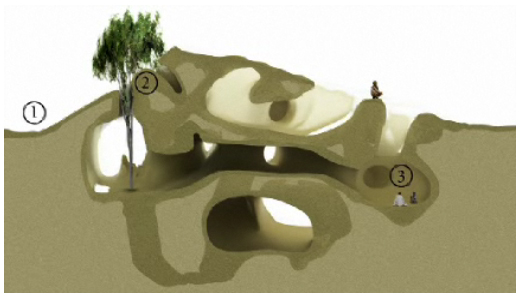Bacillus pasteuri, naturally occurring bacteria, can be used to turn sand into sandstone (calcite cement). This relatively simple process creates durable, low cost building materials. The technical name for this is microbial-induced calcite precipitation (MICP). Ginger Krieg Dosier of the United Arab Emerites was awarded the Metropolis 2010 Next Generation Winner for her innovative work. “If Dosier’s biomanufactured masonry replaced each new brick on the planet, it would reduce carbon-dioxide emissions by at least 800 million tons a year. Don’t bake the brick – grow it.”
From the above article: “Here are 12 simple steps for reproducing Dosier’s competition-winning idea. 1. Place the formwork in the sand. 2. Fill it up. 3. Level. 4. Shake the bacteria solution. 5. Pour it over the sand. 6. Let it saturate. 7. Pour the cementing solution over the sand. 8. Let it saturate. 9. Watch the brick harden. 10. Remove the formwork. 11. Watch the brick harden some more. 12. Behold, an ecobrick!”

Magnus Larsson, an architecture student who’s researching applications for MICP explains his proposed 6,000 kilometer habitable wall across Africa using bacteria-solidified sand in this TED talk.
Benefits of MICP stabilized earthbags include:
– stronger, more earthquake and hurricane resistant structures
– possibly thinner walls
– more durable water-resistant walls
– less tamping/faster construction
– less use of cement
Hurdles remain, however. The process gives off ammonia and so Dosier continues her research.
Image credit Magnus Larsson
The Better Brick: 2010 Next Generation Winner
Bio-Soil Improvement Their research involves stabilizing soils under the foundation.
Big thanks to Scott Howard of Earthen Hand for alerting me to this concept.

Hi, it’s been 12 years since this was published, has there been any advance. The world has so much sand and people need homes. This idea needs to be developed now.
There appears to be ongoing research of this process, much of it focused on ways to remediate heavy metal and other contamination.
We can’t to get this bacteria easily pls help us………, ?
Almost everything is available through the Internet…
Please help me with a starting point for my research. I live near the shore and my property is mostly a fine white sand that they call ‘sugar sand’ locally. I would like to build a house/building on site with this material, however, I don’t want to use cement. I want it to be actual stone made from this sand. I can only find the basic information online that it can be done, however, I can’t find the actual recipe for making stone from sand.
Unfortunately Owen Geiger died last year and I don’t have any more information about this.
beach rock
is the marine version of this.
into see water mix a bit of sugar and plant fertilizer, to feed the bacteria. use this to moisten your sand. the bacteria needed to make beach rock (sandstone) is already present in the water.
you will have to do a bit of experimenting to work out how much fertilizer and or sugar is needed, I suspect it will be very little.
if I was going to use this for load being or walls I would include a lot of hard rock to carry the weight.
Combine this technology with the gantry of Dr. Koshnevis at USC and you have a way to build 2,000 sf. homes in just 24 hours
Rapid automated assembly on a wide scale seems unlikely in the foreseeable future.
The method of construction – to grow the building – described in the fantastic novel “One Hundred years ahead,” Kir Bulychev. I advise you to read)
What about misting earthen walls (adobe, rammed earth, cob) or even earthen plaster with MICP and allowing it to gradually turn the surface to stone? Please let me know if you find out more about this.
Another possibility is using MICP in PISE (pneumatically impacted stabilized earth). This would create rock hard plaster that looks like stone. No cement or lime plaster required. (Note: typical PISE has cement, but MICP would make it unnecessary.)
http://www.ecomii.com/building/pise
Also note how MICP stabilized PISE wouldn’t require high pressure equipment, because it gains strength through a chemical reaction. Much lower cost and easier to use equipment like a Tirolessa mortar sprayer would would great.
http://www.mortarsprayer.com/
Apparently the bacteria is hard to come by. If you want to experiment with this, talk to a science teacher and see if they can order through a scientific supply company.
One possibility that springs to mind is using rapidly degradable natural material in place of polypropylene tubes or bags. Burlap is sprayed with nasty chemicals, but maybe you could special order burlap bags before treatment. It wouldn’t matter if the bags decomposed because you’d end up with a stone wall. You could cut away the exposed burlap to improve bonding with plaster. (For those who don’t know, using bags or tubes eliminates the need for expensive and time consuming metal or wood forms.)
Footnote: Years ago I saw stone similar to this in the desert in New Mexico and often wondered how to create houses by replicating the natural process with something like shotcrete.